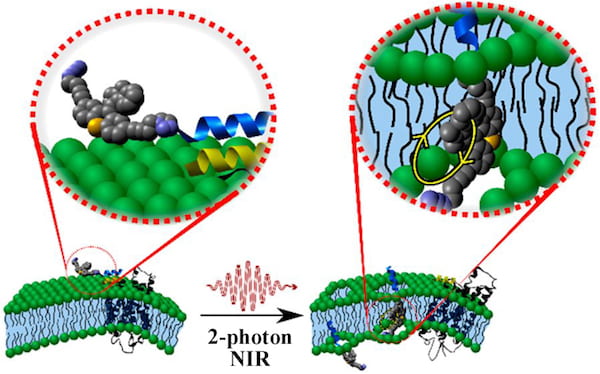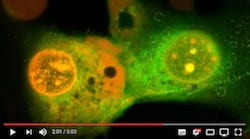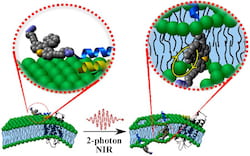NEWS RELEASE
Editor’s note: Links to video and a high-resolution image for download appear at the end of this release.
David Ruth
713-348-6327
david@rice.edu
Mike Williams
713-348-6728
mikewilliams@rice.edu
Chemists build a better cancer-killing drill
Rice U.-designed molecular motors get an upgrade for activation with near-infrared light
HOUSTON – (May 28, 2019) – An international team of scientists is getting closer to perfecting molecule-sized motors that drill through the surface of cancer cells, killing them in an instant.
Researchers at Rice University, Durham (U.K.) University and North Carolina State University reported their success at activating the motors with precise two-photon excitation via near-infrared light. Unlike the ultraviolet light they first used to drive the motors, the new technique does not damage adjacent, healthy cells.
The team’s results appear in the American Chemical Society journal ACS Nano.

Chemists at Rice University, Durham (U.K.) University and North Carolina State University have upgraded their technique to kill cancer cells with targeted molecular motors. The light-activated motors attach themselves to cells and, when hit by near-infrared light, spin up to 3 million times per second and drill through membranes, destroying the cells within minutes. Illustration courtesy of the Tour Group
The research led by chemists James Tour of Rice, Robert Pal of Durham and Gufeng Wang of North Carolina may be best applied to skin, oral and gastrointestinal cancer cells that can be reached for treatment with a laser.
In a 2017 Nature paper, the same team reported the development of molecular motors enhanced with small proteins that target specific cancer cells. Once in place and activated with light, the paddlelike motors spin up to 3 million times a second, allowing the molecules to drill through the cells’ protective membranes and killing them in minutes.
Since then, researchers have worked on a way to eliminate the use of damaging ultraviolet light. In two-photon absorption, a phenomenon predicted in 1931 and confirmed 30 years later with the advent of lasers, the motors absorb photons in two frequencies and move to a higher energy state, triggering the paddles.
“Multiphoton activation is not only more biocompatible but also allows deeper tissue penetration and eliminates any unwanted side effects that may arise with the previously used UV light,” Pal said.
The researchers tested their updated motors on skin, breast, cervical and prostate cancer cells in the lab. Once the motors found their targets, lasers activated them with a precision of about 200 nanometers. In most cases, the cells were dead within three minutes, they reported. They believe the motors also drill through chromatin and other components of the diseased cells, which could help slow metastasis.
Because the motors target specific cells, Tour said work is underway to adapt them to kill antibiotic-resistant bacteria as well. “We continue to perfect the molecular motors, aiming toward ones that will work with visible light and provide even higher efficacies of kill toward the cellular targets,” he said.
Rice postdoctoral researcher Dongdong Liu is lead author of the paper. Co-authors are Rice alumni Victor Garcia-López, Lizanne Nilewski and Amir Aliyan, visiting research scientist Richard Gunasekera, and senior research scientist Lawrence Alemany and graduate student Tao Jin of North Carolina State. Wang is an assistant professor of chemistry at North Carolina State. Pal is an assistant professor of chemistry at Durham. Tour is the T.T. and W.F. Chao Chair in Chemistry as well as a professor of computer science and of materials science and nanoengineering at Rice.
The Royal Society, the United Kingdom’s Engineering and Physical Sciences Research Council, the Discovery Institute, the Pensmore Foundation and North Carolina State supported the research.
A video produced in 2017 explains the basic concept of cell death via molecular motors.
-30-
Read the abstract at https://pubs.acs.org/doi/10.1021/acsnano.9b01556.
Follow Rice News and Media Relations via Twitter @RiceUNews.
Video:
A video produced in 2017 explains the basic concept of cell death via molecular motors. Video produced by Brandon Martin/Rice University.
Related materials:
Motorized molecules drill through cells: http://news.rice.edu/2017/08/30/motorized-molecules-drill-through-cells-2/
Tour Group: http://tournas.rice.edu/website/
Robert Pal: https://www.dur.ac.uk/research/directory/staff/?mode=staff&id=6011
Gufeng Wang: https://chemistry.sciences.ncsu.edu/people/gwang10/
Rice Department of Chemistry: https://chemistry.rice.edu
Wiess School of Natural Sciences: https://naturalsciences.rice.edu
Image for download:
https://news2.rice.edu/files/2019/05/0528_DRILL-1-WEB.jpg
Chemists at Rice University, Durham (U.K.) University and North Carolina State University have upgraded their technique to kill cancer cells with targeted molecular motors. The light-activated motors attach themselves to cells and, when hit by near-infrared light, spin up to 3 million times per second and drill through membranes, destroying the cells within minutes. (Credit: Illustration courtesy of the Tour Group/Rice University)
Located on a 300-acre forested campus in Houston, Rice University is consistently ranked among the nation’s top 20 universities by U.S. News & World Report. Rice has highly respected schools of Architecture, Business, Continuing Studies, Engineering, Humanities, Music, Natural Sciences and Social Sciences and is home to the Baker Institute for Public Policy. With 3,962 undergraduates and 3,027 graduate students, Rice’s undergraduate student-to-faculty ratio is just under 6-to-1. Its residential college system builds close-knit communities and lifelong friendships, just one reason why Rice is ranked No. 1 for lots of race/class interaction and No. 2 for quality of life by the Princeton Review. Rice is also rated as a best value among private universities by Kiplinger’s Personal Finance.



